EX-99.2
Published on August 3, 2009
Exhibit 99.2
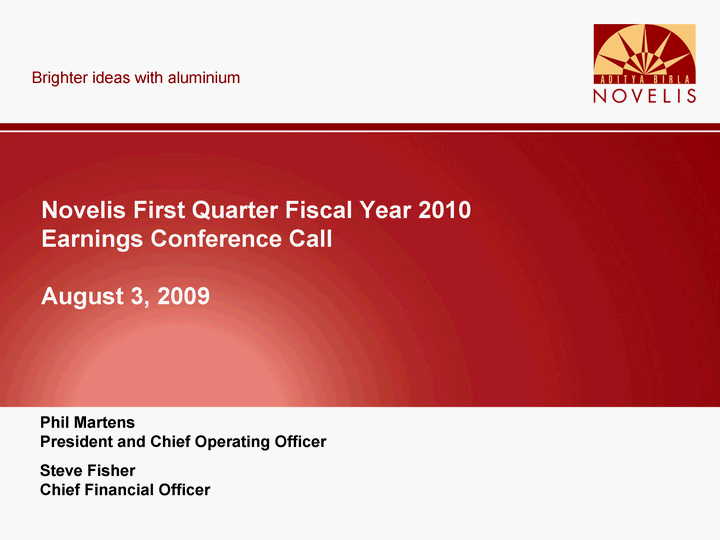
| Brighter ideas with aluminium Novelis First Quarter Fiscal Year 2010 Earnings Conference Call August 3, 2009 Phil Martens President and Chief Operating Officer Steve Fisher Chief Financial Officer |

| Safe Harbor Statement Statements made in this presentation which describe Novelis' intentions, expectations, beliefs or predictions may be forward-looking statements within the meaning of securities laws. Forward-looking statements include statements preceded by, followed by, or including the words "believes," "expects," "anticipates," "plans," "estimates," "projects," "forecasts," or similar expressions. Examples of such statements in this news release include, among other matters, the positive long-term outlook for our business; the benefits of cost reduction activities, restructurings and realignment activities; our ability to increase liquidity and manage cash; our ability to adjust our production levels; and our ability to reduce our fixed cost base, continue disciplined risk management activities and respond to economic recovery. Novelis cautions that, by their nature, forward-looking statements involve risk and uncertainty and that Novelis' actual results could differ materially from those expressed or implied in such statements. We do not intend, and we disclaim any obligation, to update any forward-looking statements, whether as a result of new information, future events or otherwise. Factors that could cause actual results or outcomes to differ from the results expressed or implied by forward-looking statements include, among other things: changes in global economic conditions, the level of our indebtedness and our ability to generate cash; relationships with, and financial and operating conditions of, our customers and suppliers; changes in the prices and availability of aluminum (or premiums associated with such prices) or other materials and raw materials we use; the effect of metal price ceilings in certain of our sales contracts; our ability to successfully negotiate with our customers to remove or limit metal price ceilings in our contracts; the effectiveness of our metal hedging activities, including our internal used beverage can and smelter hedges; fluctuations in the supply of, and prices for, energy in the areas in which we maintain production facilities; our ability to access financing for future capital requirements; continuing obligations and other relationships resulting from our spin-off from Alcan; changes in the relative values of various currencies; factors affecting our operations, such as litigation, environmental remediation and clean-up costs, labor relations and negotiations, breakdown of equipment and other events; economic, regulatory and political factors within the countries in which we operate or sell our products, including changes in duties or tariffs; competition from other aluminum rolled products producers as well as from substitute materials such as steel, glass, plastic and composite materials; our ability to maintain effective internal control over financial reporting and disclosure controls and procedures in the future; changes in the fair value of derivative instruments; cyclical demand and pricing within the principal markets for our products as well as seasonality in certain of our customers' industries; changes in government regulations, particularly those affecting taxes, environmental, health or safety compliance; changes in interest rates that have the effect of increasing the amounts we pay under our principal credit agreements and other financing arrangements; and the development of the most efficient tax structure for the Company. The above list of factors is not exhaustive. Other important risk factors are included under the caption "Risk Factors" in our Annual Report on Form 10-K for the fiscal year ended March 31, 2009, and our Quarterly Report on Form 10-Q for the quarter ended June 30, 2009, and may be discussed in subsequent filings with the SEC. Further, the risk factors included in our Annual Report on Form 10-K and our first quarter 10-Q are specifically incorporated by reference into this presentation. |

| Agenda First Quarter Highlights Economic and Market Conditions Q1 FY2010 Financial Performance Summary and Outlook Q&A |
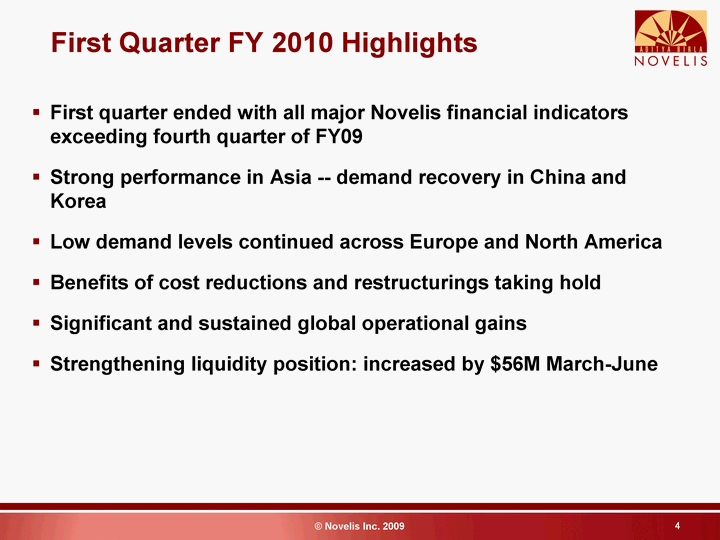
| First quarter ended with all major Novelis financial indicators exceeding fourth quarter of FY09 Strong performance in Asia -- demand recovery in China and Korea Low demand levels continued across Europe and North America Benefits of cost reductions and restructurings taking hold Significant and sustained global operational gains Strengthening liquidity position: increased by $56M March-June First Quarter FY 2010 Highlights |
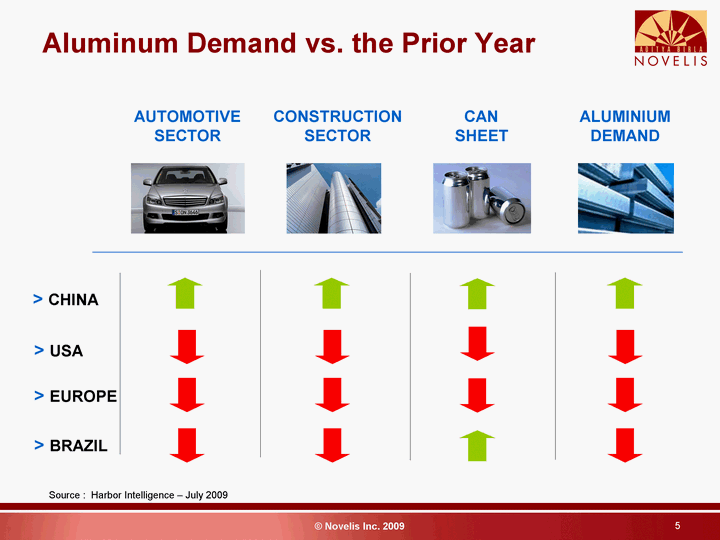
| CONSTRUCTION SECTOR AUTOMOTIVE SECTOR CAN SHEET > USA > EUROPE > BRAZIL > CHINA ALUMINIUM DEMAND Aluminum Demand vs. the Prior Year Source : Harbor Intelligence - July 2009 |
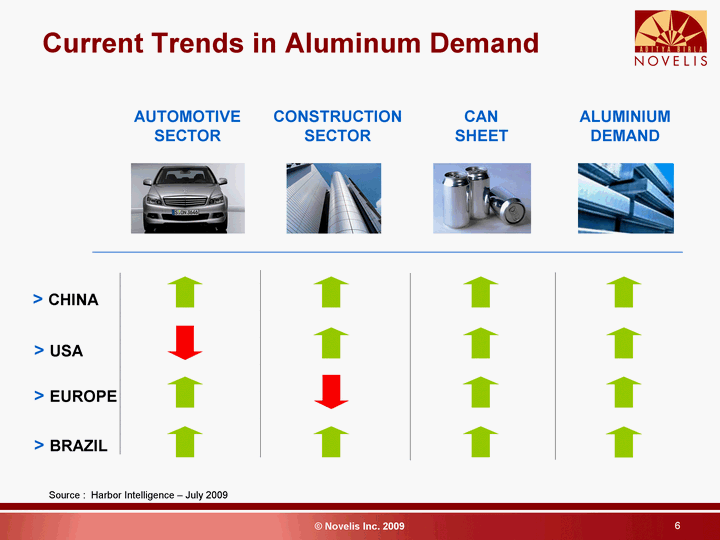
| Current Trends in Aluminum Demand CONSTRUCTION SECTOR AUTOMOTIVE SECTOR CAN SHEET > USA > EUROPE > BRAZIL > CHINA ALUMINIUM DEMAND Source : Harbor Intelligence - July 2009 |
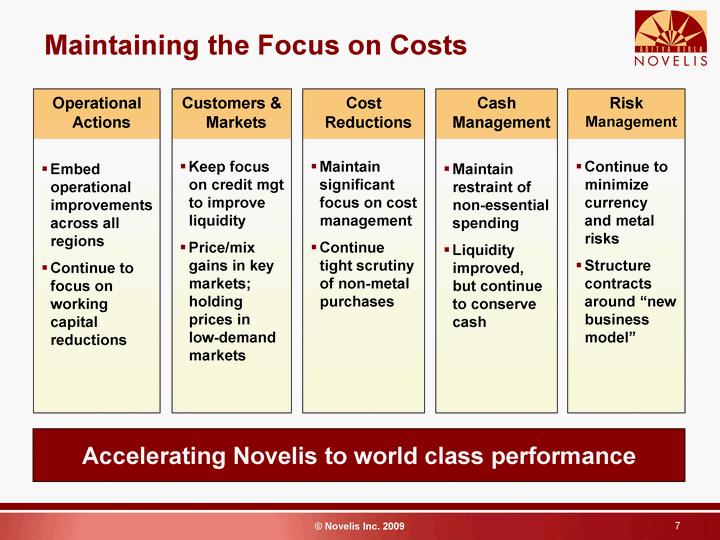
| Risk Management Continue to minimize currency and metal risks Structure contracts around "new business model" Cost Reductions Maintain significant focus on cost management Continue tight scrutiny of non-metal purchases Customers & Markets Keep focus on credit mgt to improve liquidity Price/mix gains in key markets; holding prices in low-demand markets Operational Actions Embed operational improvements across all regions Continue to focus on working capital reductions Cash Management Maintain restraint of non-essential spending Liquidity improved, but continue to conserve cash Maintaining the Focus on Costs Accelerating Novelis to world class performance |
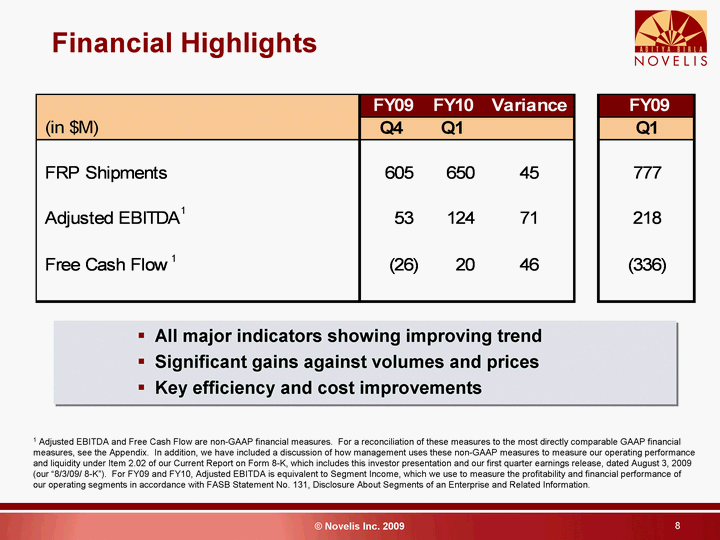
| All major indicators showing improving trend Significant gains against volumes and prices Key efficiency and cost improvements Financial Highlights 1 Adjusted EBITDA and Free Cash Flow are non-GAAP financial measures. For a reconciliation of these measures to the most directly comparable GAAP financial measures, see the Appendix. In addition, we have included a discussion of how management uses these non-GAAP measures to measure our operating performance and liquidity under Item 2.02 of our Current Report on Form 8-K, which includes this investor presentation and our first quarter earnings release, dated August 3, 2009 (our "8/3/09/ 8-K"). For FY09 and FY10, Adjusted EBITDA is equivalent to Segment Income, which we use to measure the profitability and financial performance of our operating segments in accordance with FASB Statement No. 131, Disclosure About Segments of an Enterprise and Related Information. 1 1 |

| Sequential Income Statement 1 Pre-tax income (loss) excluding items is a Non-GAAP financial measure. See the Appendix. In addition, we have included a discussion of how management uses pre-tax income (loss) excluding certain items to measure our operating performance in our 8/3/09 8-K. 1 |

| PY Price & Mix Operating Costs FX G/L Can Price Ceiling Volume Metal Price Lag Metal Long Position Purchase Accounting Other Q1 FY10 East 0 218 293 333 351 262 194 144 133 124 0 218 75 40 18 20 109 68 50 11 9 124 Adjusted EBITDA Q1 FY10 vs PY Significant volume losses and unfavorable metal impacts partly offset by pricing and mix improvements and lower costs 1 1 Non-GAAP financial measure. See the Appendix and our 8/3/09 8-K. 10 |
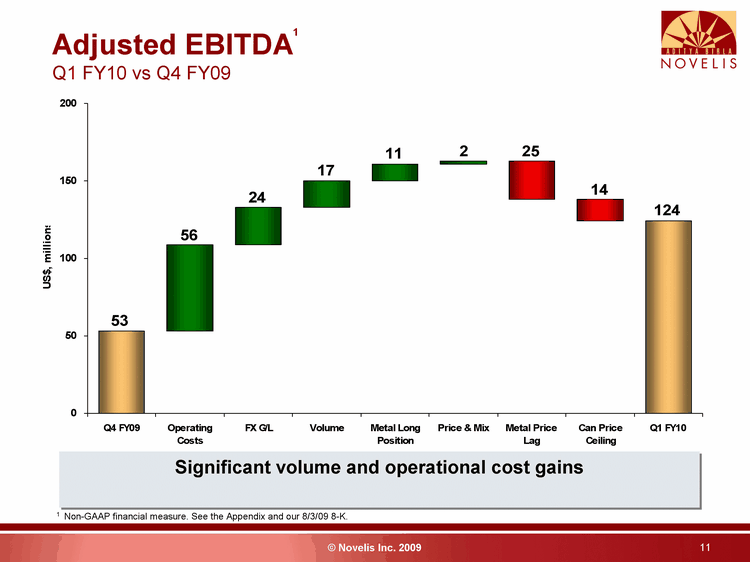
| Q4 FY09 Operating Costs FX G/L Volume Metal Long Position Price & Mix Metal Price Lag Can Price Ceiling Q1 FY10 East 0 53 109 133 150 161 138 124 0 53 56 24 17 11 2 25 14 124 Adjusted EBITDA Q1 FY10 vs Q4 FY09 Significant volume and operational cost gains 1 Non-GAAP financial measure. See the Appendix and our 8/3/09 8-K. 1 11 |
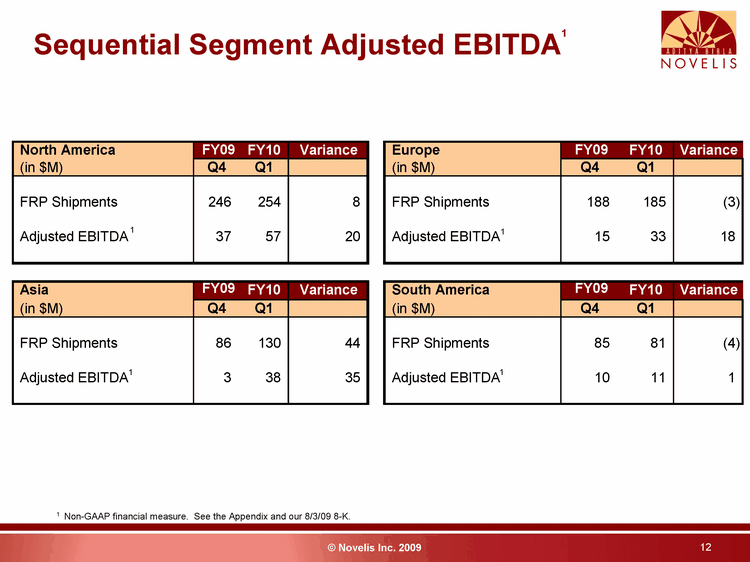
| Sequential Segment Adjusted EBITDA 1 Non-GAAP financial measure. See the Appendix and our 8/3/09 8-K. 1 1 1 1 1 12 |
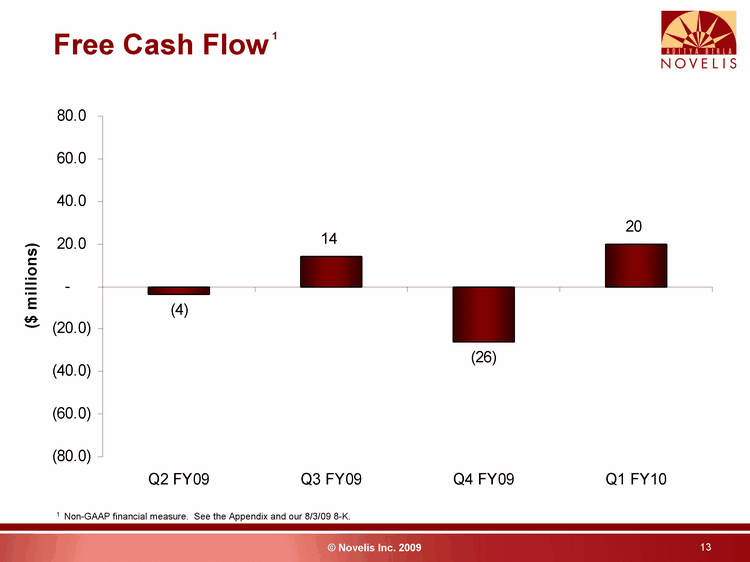
| Free Cash Flow 1 Non-GAAP financial measure. See the Appendix and our 8/3/09 8-K. 1 13 |

| Adequate Liquidity 561 397 390 446 |
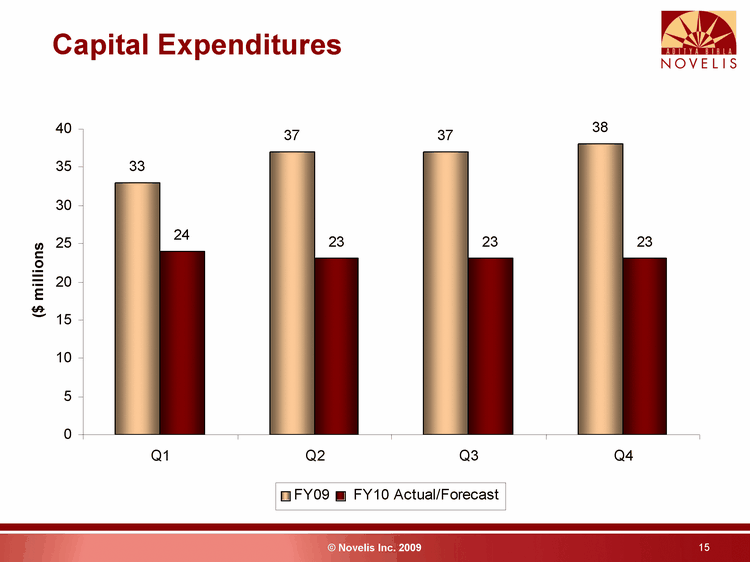
| Capital Expenditures 15 |

| Business Summary Beginning to see benefits of cost reductions and restructurings Significant operational gains in Q1 Strong performance in Asia with demand recovery in China and Korea Liquidity is adequate and improving Going Forward: Continue aggressive actions to reduce overall fixed cost base Maintain cash conservation to further improve liquidity Continue disciplined risk management Focus on core activities Be ready to respond to economic recovery Pursue transformation to "One Novelis" |
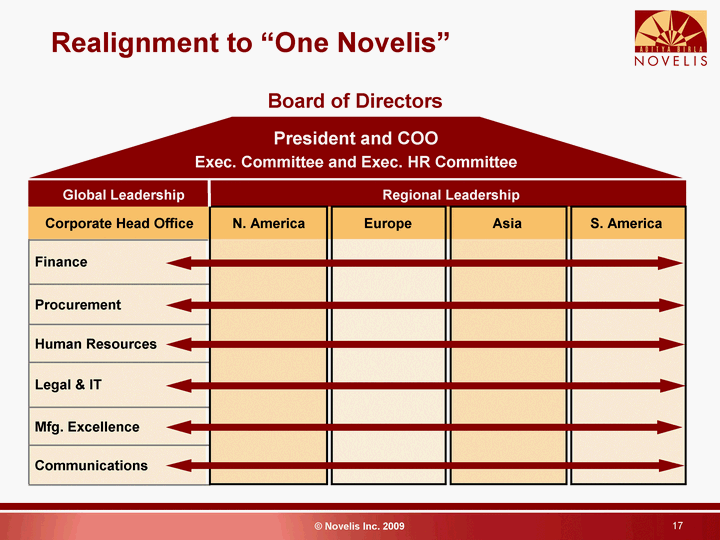
| Realignment to "One Novelis" Board of Directors Global Leadership Regional Leadership Communications Mfg. Excellence Legal & IT Human Resources Procurement Finance S. America Asia Europe N. America Corporate Head Office President and COO Exec. Committee and Exec. HR Committee |
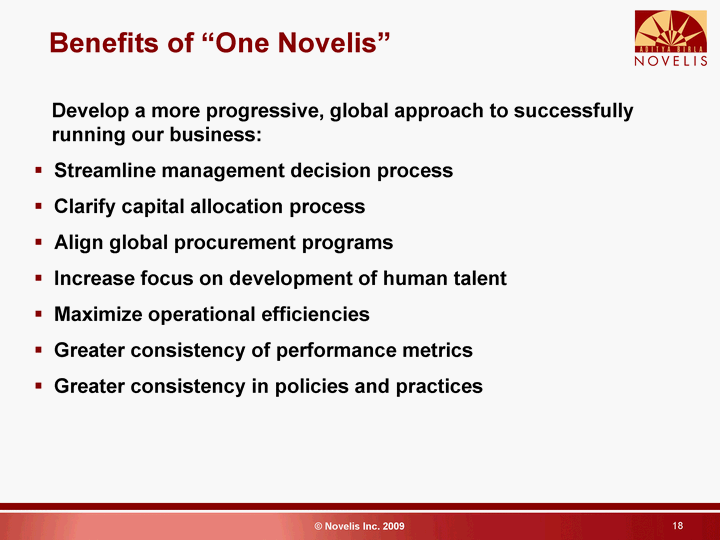
| Benefits of "One Novelis" Develop a more progressive, global approach to successfully running our business: Streamline management decision process Clarify capital allocation process Align global procurement programs Increase focus on development of human talent Maximize operational efficiencies Greater consistency of performance metrics Greater consistency in policies and practices |

| Questions? |
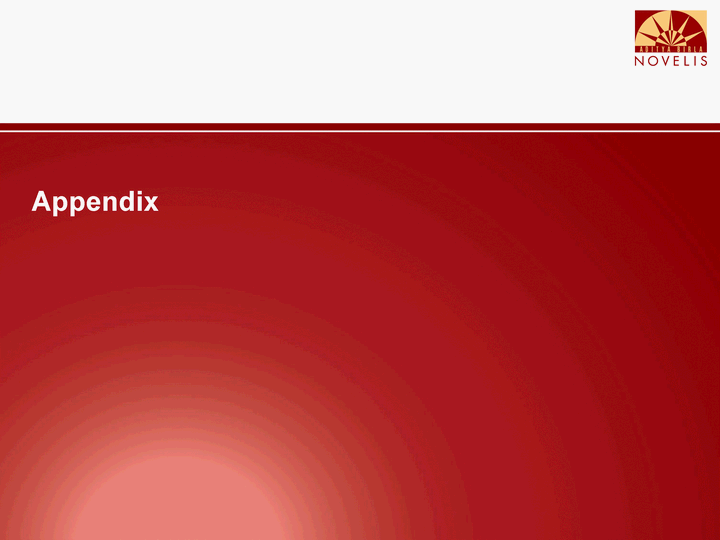
| Appendix |
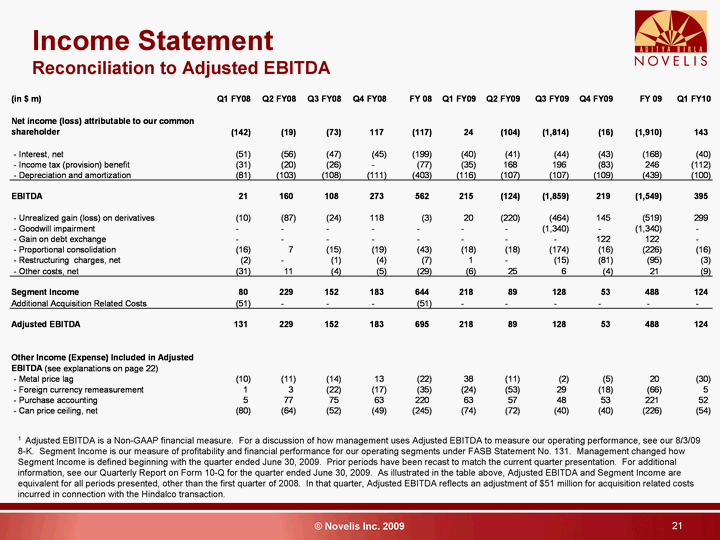
| Income Statement Reconciliation to Adjusted EBITDA 1 Adjusted EBITDA is a Non-GAAP financial measure. For a discussion of how management uses Adjusted EBITDA to measure our operating performance, see our 8/3/09 8-K. Segment Income is our measure of profitability and financial performance for our operating segments under FASB Statement No. 131. Management changed how Segment Income is defined beginning with the quarter ended June 30, 2009. Prior periods have been recast to match the current quarter presentation. For additional information, see our Quarterly Report on Form 10-Q for the quarter ended June 30, 2009. As illustrated in the table above, Adjusted EBITDA and Segment Income are equivalent for all periods presented, other than the first quarter of 2008. In that quarter, Adjusted EBITDA reflects an adjustment of $51 million for acquisition related costs incurred in connection with the Hindalco transaction. |
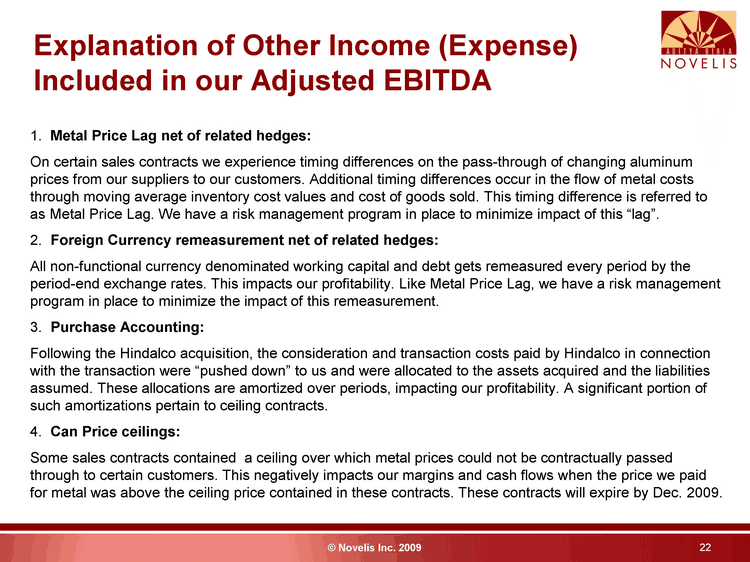
| Explanation of Other Income (Expense) Included in our Adjusted EBITDA 1. Metal Price Lag net of related hedges: On certain sales contracts we experience timing differences on the pass-through of changing aluminum prices from our suppliers to our customers. Additional timing differences occur in the flow of metal costs through moving average inventory cost values and cost of goods sold. This timing difference is referred to as Metal Price Lag. We have a risk management program in place to minimize impact of this "lag". 2. Foreign Currency remeasurement net of related hedges: All non-functional currency denominated working capital and debt gets remeasured every period by the period-end exchange rates. This impacts our profitability. Like Metal Price Lag, we have a risk management program in place to minimize the impact of this remeasurement. 3. Purchase Accounting: Following the Hindalco acquisition, the consideration and transaction costs paid by Hindalco in connection with the transaction were "pushed down" to us and were allocated to the assets acquired and the liabilities assumed. These allocations are amortized over periods, impacting our profitability. A significant portion of such amortizations pertain to ceiling contracts. 4. Can Price ceilings: Some sales contracts contained a ceiling over which metal prices could not be contractually passed through to certain customers. This negatively impacts our margins and cash flows when the price we paid for metal was above the ceiling price contained in these contracts. These contracts will expire by Dec. 2009. 22 |
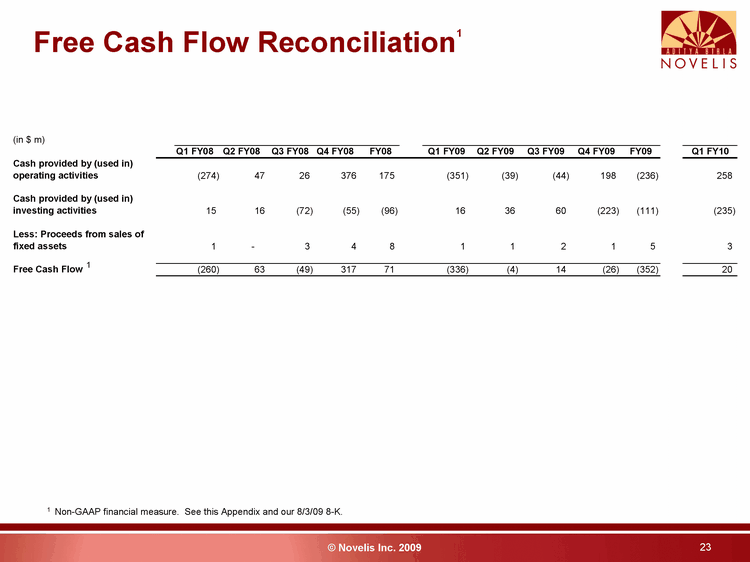
| Free Cash Flow Reconciliation 1 Non-GAAP financial measure. See this Appendix and our 8/3/09 8-K. 1 1 23 |